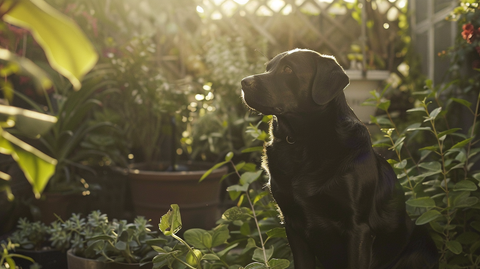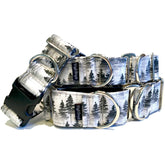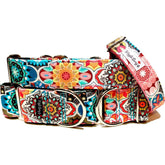Dog-Friendly Gardening Tips: Ultimate Guide for a Safe Pet Haven

- Key Takeaways
- Understanding Dog-Friendly Gardening
- Identifying Toxic and Safe Plants for Pets
- Designing a Petscaping Garden
- Selecting Suitable Plants and Borders
- Using Containers and Raised Beds
- Establishing Secure Boundaries and Fences
- Designating Play Spaces in Your Garden
- Protecting Plants and Lawn from Pets
- Providing Shelter and Shade for Dogs
- Closing Thoughts
-
Frequently Asked Questions
- What plants are safe for my dog in the garden?
- How can I create a dog-friendly garden space?
- What's the best way to protect my garden from my dog?
- Can dogs enjoy gardens without ruining them?
- How do I provide shelter and shade for my dog in the garden?
- Are there any tips for selecting suitable border materials that are also safe for pets?
Did you know that over 60% of dog owners are clueless about the dangers their gardens pose to their furry friends? It's a shocking statistic, but it's true. Our gardens can be minefields for our pets if we're not careful. But don't sweat it; turning your green space into a safe haven for your four-legged buddy is easier than you think. This post dives into simple yet effective dog-friendly gardening tips that ensure your garden is a joy, not a hazard, for every member of the family—tail-waggers included. From non-toxic plants to secure fencing ideas, we've got you covered. Let's dig in and make sure our gardens are as welcoming to our dogs as they are to us.
Key Takeaways
-
Recognize the importance of creating a garden that is both enjoyable for you and safe for your pets by understanding dog-friendly gardening principles.
-
Always check the toxicity of plants before incorporating them into your garden, prioritizing the selection of pet-safe options to prevent accidental poisoning.
-
Consider petscaping by designing your garden with both aesthetics and pet safety in mind, including the use of suitable plants, borders, and strategic layouts that accommodate your dog's habits.
-
Utilize containers and raised beds to keep delicate plants out of reach from pets, ensuring both the beauty of your garden and the safety of your furry friends.
-
Establish secure boundaries and fences to prevent pets from wandering out of safe areas, while also designating specific play spaces to encourage active engagement within a secure environment.
-
Ensure your garden includes shelter and shaded areas to protect dogs from the elements, demonstrating a comprehensive approach to pet-friendly gardening that considers their comfort and well-being.
Understanding Dog-Friendly Gardening
Non-Toxic Plants
Choosing non-toxic plants is crucial for a dog-friendly garden. Many common garden plants can be harmful to pets if ingested. For instance, azaleas and lilies are toxic to dogs and can cause severe health issues.
Research is key before planting anything. Opt for pet-safe options like roses, sunflowers, and snapdragons. These add color without the risk.
Sensory Elements
Dogs experience the world through their senses. Incorporating elements that stimulate these can make your garden more enjoyable for them. Think of adding various textures underfoot such as grass, sand, or smooth stones.
Planting herbs like lavender can also appeal to your dog's sense of smell. Just ensure they're safe for dogs.
Aesthetic Balance
Balancing aesthetics with pet safety might seem challenging but it's achievable with some planning. Designate areas where your dog can play freely without damaging delicate plants or decorations. Use raised beds or fences to protect certain areas.
Creating a space that both you and your pet enjoy doesn't have to compromise on style or safety. With thoughtful choices in plants and materials, everyone wins.
Identifying Toxic and Safe Plants for Pets
Toxic Plants
Creating a dog-friendly garden means knowing which plants are no-nos. Many common garden plants can harm your furry friend. It's crucial to recognize these poisonous plants.
Some toxic plants include lilies, sago palm, and tulips. These contain harmful chemicals that can make dogs sick. Symptoms might be mild or severe, depending on the plant and how much your pet eats.
To keep your garden safe, avoid planting azaleas, oleander, and chrysanthemum too. Dogs curious about new smells might nibble on these with dangerous outcomes.
Safe Plants
Fortunately, many non-toxic options exist for a pet-safe garden. These safe plants add beauty without posing risks to dogs.
Consider adding roses (minus the thorns), snapdragons, or marigolds to your space. They offer color and variety while keeping pets out of harm's way.
Herbs like basil and rosemary are also great choices. Not only do they provide fresh flavors for cooking but they're safe around dogs too.
Pet-Safe Resources
When planning your dog-friendly gardening project, reliable resources are invaluable.
The ASPCA’s list of pet-safe plants is a fantastic tool for any gardener with pets. It details both safe and poisonous options clearly.
By consulting this list before buying new plants:
-
You ensure the safety of your pets
-
Avoid accidental poisoning instances
Remembering these tips helps create a beautiful garden that everyone in the family—including four-legged members—can enjoy safely.
Designing a Petscaping Garden
Path Planning
Creating paths in your garden is not just about aesthetics. It's also about guiding your furry friends through safe areas. Design paths wide enough for dogs to trot comfortably without trampling your beloved plants. Use materials that are gentle on their paws, like mulch or smooth pebbles.
Paths serve a dual purpose. They let pets explore while keeping them away from delicate areas. You can lead these paths to dog-friendly zones, ensuring they enjoy the outdoors as much as you do.
Dog-Friendly Zones
Incorporate spaces in your garden where dogs can indulge in their natural behaviors. A digging box or sandpit is perfect for those who love to dig. Fill it with loose soil or sand, and watch them enjoy hours of fun without ruining your flower beds.
Adding these features not only keeps your pets entertained but also saves your plants from being destroyed. It’s a win-win situation for both you and your furry companion.
Supervision Made Easy
The layout of your garden should allow you to keep an eye on your pets easily. Place seating areas where you have clear views of the entire garden, including the dog-friendly zones and pathways.
This ensures that while enjoying the beauty of nature, you can supervise their playtime effortlessly.
-
Easy supervision means less worry.
-
Keeping an eye out becomes part of relaxing outside.
Selecting Suitable Plants and Borders
Sturdy Plants
Choosing the right plants is crucial for a dog-friendly garden. Sturdy, non-toxic plants are best. They can handle pets running around and won't harm them if nibbled on.
Many plants fit this bill perfectly. For example, ferns and marigolds are tough yet safe for dogs. These plants can bounce back after being trampled by playful paws. But remember, not all common garden plants are pet-safe. Before bringing new plants home, check their toxicity.
Soft Borders
Creating clear but gentle borders in your garden helps both you and your pet understand where it's okay to play or dig. Use soft, low borders like mulch or small bushes instead of harsh fences or walls.
This approach keeps the garden looking beautiful without restricting access too much. It also prevents injuries that could happen with sharp-edged borders.
Avoid using rocks or metals as border materials near play areas. They can be hard on paws and lead to accidents during rough play sessions.
Safe Pathways
Keeping paths free from thorny or spiky plants is another key aspect of a dog-friendly garden design. Paths should be clear so pets can run freely without getting hurt.
Instead of planting roses right next to walkways, consider placing them further back in the flower beds. Grass pathways are great because they're soft underfoot for both humans and animals alike. Steer clear of adding new plants with sharp leaves along these routes.
Creating a space where your furry friend can enjoy without worry takes some planning but pays off in safety and fun. Remember these tips when selecting plants and designing borders in your petscaping project:
-
Choose sturdy, non-toxic greenery
-
Opt for soft boundaries
-
Keep play zones free from harmful flora
By incorporating these guidelines into your gardening plans, you'll craft an environment that's enjoyable for both you and your pet. It makes all the difference between a good outdoor space and a great one.
Using Containers and Raised Beds
Plant Protection
After choosing the right plants for your garden, protecting them becomes crucial. Raised beds and sturdy containers are excellent for keeping delicate plants safe from playful or curious pets. Not only do they provide a barrier, but they also help in organizing your garden space efficiently.
Using raised beds can significantly reduce the risk of dogs trampling over sensitive vegetables or flowers. These structures elevate the plants off the ground, making it harder for pets to reach them. As an added bonus, raised beds can also improve soil drainage and make gardening easier on your back.
Secure Positioning
Positioning is key when integrating containers into a dog-friendly garden. It's important to place these containers where they won't easily tip over if bumped by larger breeds. Opting for heavy or anchored pots can prevent any accidents that might harm both your pet and your plants.
For example, placing large stone or ceramic pots at strategic points around the garden not only adds aesthetic value but also ensures stability against playful dogs. You could even secure lighter pots by embedding them slightly into the ground or using stakes to anchor them firmly in place.
Anchor Wisely
Choosing heavy-duty materials for your containers is another step towards creating a harmonious space shared between you and your furry friend. Materials like concrete, thick plastic, or terracotta are less likely to be knocked over compared to lightweight options.
-
Concrete planters offer great durability.
-
Thick plastic is sturdy yet lighter than stone.
-
Terracotta provides a classic look while being relatively weighty.
Remember that whatever material you choose should complement both your garden’s design and its practical needs considering dog-friendliness.
Prevent Tipping
To further ensure that larger breeds don't accidentally tip over containers:
-
Place heavier stones inside lighter pots.
-
Use pot stabilizers available at gardening stores.
-
Arrange furniture strategically around freestanding pots as barriers.
Establishing Secure Boundaries and Fences
Fence Height
Installing fences high enough is crucial. Dogs can jump surprisingly high. A fence too low might not stop them from leaping over to explore or chase something on the other side.
To keep your furry friend safe, measure their jump capability. Then, add a few extra feet to that height for your fence. This way, even the most athletic dogs stay within the safety of your yard.
Ground Gaps
Check for gaps at ground level regularly. Dogs are curious and can squeeze through smaller spaces than you'd think.
Walk along your fence line, looking closely for any potential escape routes. Pay special attention to areas where the ground might have eroded or sunk beneath the fence. Fill these gaps with dirt or use chicken wire as a quick fix until you can make more permanent repairs.
Visual Barriers
Some dogs bark at everything they see outside their territory. For peace and quiet, consider adding visual barriers along your fence line.
This could be in the form of tall plants, privacy screens, or solid fencing materials that block out tempting stimuli from beyond their boundary. Not only does this reduce barking but it also helps keep your dog focused on their own space rather than what's happening outside it.
Designating Play Spaces in Your Garden
Play Zones
After setting up secure boundaries and fences, it's time to focus on creating play areas within your garden. This ensures your dog has a designated space for fun without ruining the rest of your yard. First, decide on the best spot for this area. Look for a place that is visible from the house but also offers enough room for your dog to run and play.
Creating a specific area for toys and active play keeps both pets and plants happy. Use durable materials like turf or mulch in these zones. They can handle heavy paw traffic without getting easily damaged. Plus, they're comfortable for dogs to run and lie on.
Interactive Features
Incorporate agility equipment or interactive toys into these spaces to keep dogs engaged. Options include tunnels, ramps, or even homemade obstacle courses using safe household items.
-
Tunnels offer an exciting challenge.
-
Ramps help with exercise.
-
Homemade obstacles spark curiosity.
This not only enriches their environment but also provides vital physical activity right in their backyard.
Protecting Plants and Lawn from Pets
Bathroom Training
Training pets to use specific bathroom areas keeps gardens safe. It prevents damage to plants and lawns. Start by choosing a spot away from your garden. Use positive reinforcement when your pet uses it correctly.
Pets, especially dogs, can learn quickly with consistent training. Reward them with treats or praise for using the designated area. This method protects your garden without harming your pet.
Safe Deterrents
Use deterrents that won't harm pets or plants around valuable greens. Natural options are best, like citrus peels or coffee grounds. They keep curious pets at bay without chemicals.
Some commercial products are safe for pets but always check labels carefully. A vet can recommend pet-safe options too. Remember, the goal is to gently discourage pets, not harm them.
Robust Lawns
Choose lawn varieties that withstand playful and curious pets better. Some grasses recover quickly from wear and tear caused by running or digging animals.
Options include:
-
Bermuda
-
Zoysia
-
Tall Fescue
These types remain green and lush despite heavy pet activity. They require less repair over time compared to delicate varieties.
Providing Shelter and Shade for Dogs
Shaded Spots
Creating shaded spots in your garden is essential, especially during hot weather. Dogs need a cool place to rest after playing or walking around the yard. You can achieve this by planting trees or tall shrubs. They not only add beauty to your garden but also provide natural shade where your dog can relax.
Trees like maples or oaks grow large enough to cast a wide shadow, offering an excellent spot for your canine friend. Shrubs such as rhododendrons can create cooler areas at ground level, perfect for dogs who love to lie down on the dirt.
Shelter Options
Building a doghouse is another great way to ensure your pet has shelter from sun and rain. It's important that this shelter be placed within the garden but away from direct sunlight. This way, even on the hottest days, your dog has a safe retreat.
When choosing materials for the doghouse, consider using cedar chips for bedding inside it. Cedar chips repel some pests and provide a comfortable resting place for dogs. Ensure the house is big enough for them to stand up and turn around comfortably but cozy enough to keep them warm during colder months.
Closing Thoughts
Creating a dog-friendly garden isn't just about making your yard safe for your furry friends, but it's also about crafting a space where you and your pets can relax and enjoy nature together. From picking out non-toxic plants to setting up secure fences, every step you take brings you closer to a garden that's both beautiful and pet-friendly. It's like mixing a salad with all your favorite ingredients; everything has to blend well for the perfect taste.
Now, don't let the journey stop here. Grab your gardening gloves, call over your four-legged companion, and start turning those plans into action. Remember, the best gardens are those that grow and evolve with love and care—paw prints included. So, what are you waiting for? Let's dig in and create an oasis that celebrates the bond between humans and their canine companions. Your garden awaits!
Frequently Asked Questions
What plants are safe for my dog in the garden?
Safe plants for your furry friend include sunflowers, marigolds, and snapdragons. They add color without the worry. Always double-check with a pet-safe plant list before planting.
How can I create a dog-friendly garden space?
Start by choosing non-toxic plants and sturdy borders. Incorporate play areas and paths for exploration. Raised beds help keep curious noses away from your prized peonies!
What's the best way to protect my garden from my dog?
Use raised beds or containers to elevate plants out of reach. Establish clear boundaries with secure fencing, and designate specific play zones to distract them from more delicate areas.
Can dogs enjoy gardens without ruining them?
Absolutely! With some planning, you can have both a beautiful garden and a happy pooch. Designate play spaces, use durable plants, and provide plenty of toys to keep them entertained.
How do I provide shelter and shade for my dog in the garden?
A simple canopy or shaded patio area works wonders. Ensure there’s always a cool spot available on hot days where your dog can relax away from direct sunlight.
Are there any tips for selecting suitable border materials that are also safe for pets?
Opt for smooth stones or thick hedges rather than sharp-edged materials like metal edging or certain mulches that could harm paws or be ingested accidentally.


















































































































